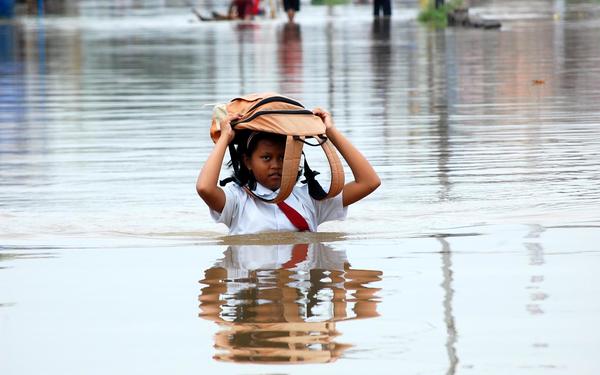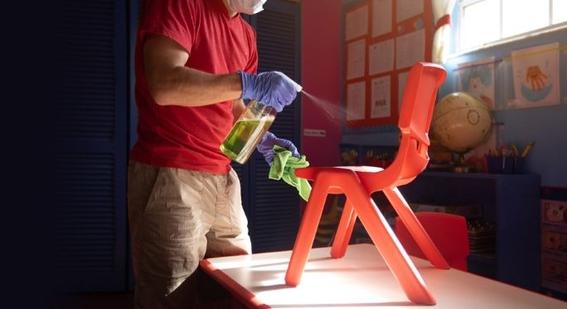Jane Mann, Managing Director, Cambridge Partnership for Education
In July, the UK co-hosted the Global Education Summit in London. This week, the UK is welcoming delegates to COP26 in Glasgow, Scotland. In January, we’ll be back in London for the Education World Forum. This education-climate summit sandwich sees world leaders and ministers of education discuss two of the most important global challenges, quality education and the climate crisis, in quick succession. It brings attention to the strong links between UN Sustainable Development Goal 4 (quality education for all) and goal 13 (climate action). It demands we consider the huge risks climate change poses to education, and explore how education can be an important tool to unlock a greener future.
The impact of climate disasters on education
Failure to take climate action will disrupt education. As global temperatures rise, the frequency and severity of climate-related disasters increase. According to UNICEF, approximately 1 billion children live in countries at extremely high risk of climate and environmental hazards, shocks and stresses – almost half the world’s children.
Climate disasters such as fires, droughts, floods and earthquakes, can destroy infrastructure – from access to school buildings to internet connectivity, impact mental and physical health, and more. Climate disasters have also been linked with early marriage, schools drop-outs and teen pregnancy. In the wake of a global pandemic, we all acutely understand the severity of these potential events, and the challenges of building back and forward.
Many countries are not new to disruption from climate challenges, and it may be those who are already vulnerable who are hit hardest by further disasters. In our recent webinar on inclusive technology with the Digital Education Futures Initiative (DEFI), Social Innovator and Development Strategist Teocah Dove spoke to the huge impact of climate disasters on children in the Caribbean, from disrupting high-stakes exams to increasing the digital divide to resulting in fewer opportunities to work.
Education as a solution to climate change
However, education can also play a role in combatting rising emissions. This year, we’ve seen escalating calls for education to be recognised as a central solution to the climate crisis. The Brookings Institute, the Malala Fund and others have released reports demonstrating the immense potential for education to help combat climate change. During the summer, 60 non-governmental organisations wrote to Alok Sharma, President of COP26, to request climate funds be allowed to cover programmes focused on reproductive healthcare and girls’ education. Several researchers and organisations are joining sessions at COP to bring education to the forefront of discussion. These noises aren’t new, with experts calling for similar discussion ahead of COP25 and earlier, but their volume is increasing.
At Cambridge, we believe in the transformative power of education to generate a more sustainable future. Education raises awareness of the climate crisis, and builds knowledge and skills needed to tackle it. The Cambridge Zero Policy Forum, in its report on a green recovery from Covid-19, stressed that ‘A global transition to a zero-carbon economy that values nature needs investment in knowledge capital and innovation.’ They recommend we ‘review and overhaul the entire lifelong learning portfolio, including education, training, and re-skilling, to boost societal knowledge and understanding of sustainability and to underpin the employment opportunities of the future.’
Scientists estimate that another 500 gigatons of carbon emissions around the world will result in a 50% chance of the global temperature increasing beyond 1.5°C – the temperature seen as the threshold for limiting the most severe effects of climate change. Education alone could save 21% of these emissions. Research suggests that ensuring access to education for all in low- and lower-middle-income countries could reduce emissions by 51.48 gigatons by 2050. Project Drawdown predicts 85.4 gigatons of emissions could be avoided if we put in place quality girls’ education and reproductive healthcare access in the same time period.
Linking climate and education activities
There are many ways to consider aligning education and climate ambitions. From ‘greening the curriculum’, by either introducing climate based subjects or by embedding green issues in every subject, to introducing symbiotic climate and education policies. In the UK, the exam board OCR, also part of Cambridge University Press & Assessment, has worked with conservationist and broadcaster Mary Colwell to put forward a proposal for a new secondary qualification in Natural History. Christina Kwuak and Olivia Casey at the Brookings Institute suggest a green skills framework with three strands: developing skills aimed at fulfilling the requirements of green jobs, introducing cross-cutting ‘green life’ skills, and building adaptive skills aimed at transforming social and economic structures.
So, how can you translate this evidence and discussion into action in your country? COP26 will bring a number of opportunities to spotlight the important role of education in combatting climate change, which I encourage you to contribute to and amplify in your network. Then, we must carry this energy and insight with us through the Education World Forum and beyond. We look forward building on this momentum and taking the conversation forward with you.
Recommended reading
- A new green learning agenda: Approaches to quality education for climate action (Kwauk and Casey, The Brookings Institute, 2021)
- A greener, fairer future: Why leaders need to invest in climate and girls’ education (Malala Fund, 2021)
- The Climate Crisis is a Child Rights Crisis (UNICEF, 2021)
- Making the case for Education and Climate Change (TheirWorld, 2021)
- Education agenda at COP26 (Global Partnership for Education, 2021)
- A Blueprint for a Green Future – Multidisciplinary report on a green recovery from COVID-19 (Cambridge Zero Policy Forum, 2020)
More from Cambridge University Press & Assessment ahead of COP26
Cambridge University Press & Assessment has shared an essential climate change reading list, and our Cambridge English team has taken a look at climate-related new words and teaching tips.





